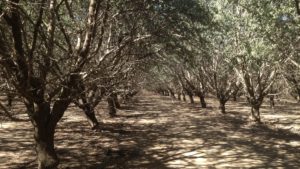 Increasing input prices are being observed across the farming sector. Fertilizer prices have increased due to demand, government regulations, weather, trade issues, and energy prices. Prices are some of the highest in a decade, with nitrogen and phosphate fertilizer prices nearly double what they were in 2020.
Increasing input prices are being observed across the farming sector. Fertilizer prices have increased due to demand, government regulations, weather, trade issues, and energy prices. Prices are some of the highest in a decade, with nitrogen and phosphate fertilizer prices nearly double what they were in 2020.
Within almonds, maintaining the proper fertilizer status within the tree is important to maintain yields. Research projects have determined how much of each major nutrient is needed for the tree to maximally produce. These studies first occurred in the early 1990’s and were re-done between 2008-2013. In summary, the projects concluded that for every 1000 lbs of almond kernels harvested, 68 lbs of nitrogen, 92 lbs of K2O, and ~12 lbs of P2O5 are removed from the orchard.
These nutrients need to be re-applied to maintain yields. Leaf tissue, soil samples and other in-season assays and monitoring can be used to determine if optimal levels have been achieved. If optimal levels are present, input levels should only match crop demand, while if excess amounts are present, applications can be reduced. These adjustments will help reduce waste, run-off, and leaching. More on this here and here.
Nitrogen (N) usage and uptake occurs when there are leaves on the tree. As such, N applications should only occur in-season. When applying N, more than 68 lbs/1000 kernel pounds of production is applied – typically around 85 lbs/1000 kernel pounds of production. This inefficiency of about 20-30% considers the N lost to NOx conversion, run-off, and leaching. Fortunately, I have observed many orchards much more efficient than this. These orchards have been able to reduce N amounts applied based on the observation of high N within leaf samples. They have found that maintaining N levels at 2.5% in mid-July allow for the maintenance of high yields (>3000 lbs/acre). If leaf levels are higher, N application rates are reduced to bring leaf N back down to this level. In some cases, I have observed 20-30 lbs/acre (22-33 kg/ha) in reduced N amounts.
If an orchard has historically high mid-July leaf samples, reducing in-season N applications can help save money while not impacting yields. It is thought that for every 0.1% of leaf N over 2.5%, application rates can be reduced by 10 lbs/acre (11 kg/ha). This is a guideline, and should be tried, and modified based on orchard performance.
N rates can be further reduced by available soil N. Soils should be sampled at the beginning of the spring so that it accounts for leaching losses due to winter rains. A formula to determine the amount of plant available N is below. N applications should be reduced by the amount present in the soil.

Almond trees are also a major potassium (K) user. This material is applied as either a granular application in the fall and winter, or as liquids in-season. Due to the importance of K for spur viability, adequate levels of K should be applied to keep mid-July leaf levels at 1.5%. Having values higher than 1.5% has not been shown to increase yields. In cases of high leaf levels, soil samples should be conducted to determine how much K is available and corresponding rates can be reduced. Soil levels above 150 ppm exchangeable K are sufficient, and levels above this can be subtracted from fertilizer applications using the same formula as above. More information on K management can be found here and here.
Phosphorus (P) is utilized at lower levels within almonds. This major nutrient is often over-applied within California soils. In many cases, soil P levels are excessively high and P deficiency has never been (or rarely been) diagnosed in California. P, however, does not have as straight forward of an uptake as N and K. Most of plant uptake occurs through diffusion, in which P is pulled into the plant along a concentration gradient. This process often requires the assistance of soil microbes, which can increase the availability of the P.
Soil tests can offer insight into better P management. Traditionally, soil extractions have provided some guidance on the availability of P. Within CA, most laboratories have utilized either the Olsen or Bray P1 soil test, depending on soil pH. If the soil pH is greater than 6.5, the Olsen extraction should be used, while the Bray P1 test can be used if pH is less than 7.0. Sufficiency levels for Olsen are 5-10ppm, and 10-20 ppm for Bray. Personally, I do not apply additional P if soil levels are above 8 and 18 ppm for Olsen and Bray tests, respectively.
Recently, there is an increasing awareness of the effects of soil exchange site saturation and presence of microbes that help increase P availability. One company, Trace Genomics, has developed a more comprehensive test accounting for these factors. This is distilled into a value called a “TracePLUS Phosphorus Score,” which can be used to guide fertilizer decisions. It also provides insight to whether a P solubilizing chemical or microbial product would help increase P availability.
There has been a lot of research on the major nutrients and usage within almonds. The thoughts above are simple refinements of these recommendations based on my experiences and observations. When changing nutrient management practices, follow-up soil and tissue sampling should occur to provide guidance. These tools, when used and correctly interpreted, can prevent over-application of major nutrients, saving money and reducing negative off-target impacts.
Disclosure: I currently am serving as a technical adviser for Trace Genomics and receive compensation for my involvement. Trace Genomics, however, has not paid me for the reference above. I have simply found the insights from the P-Score to be useful in guiding P fertilization.

